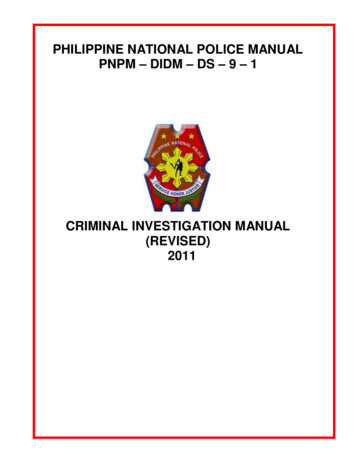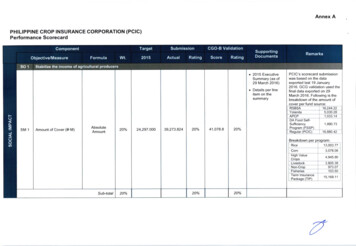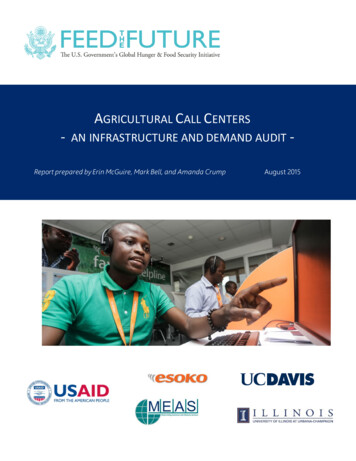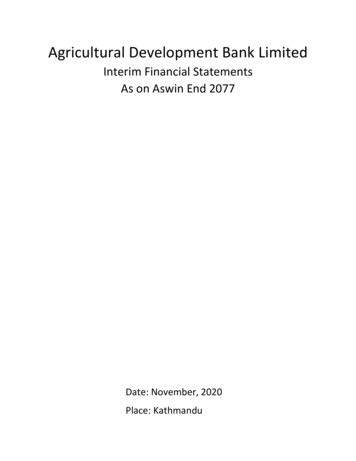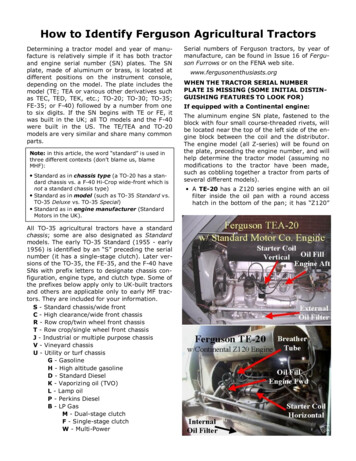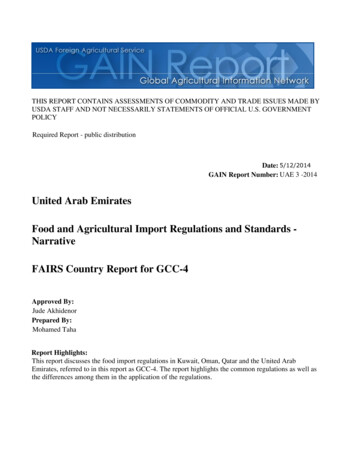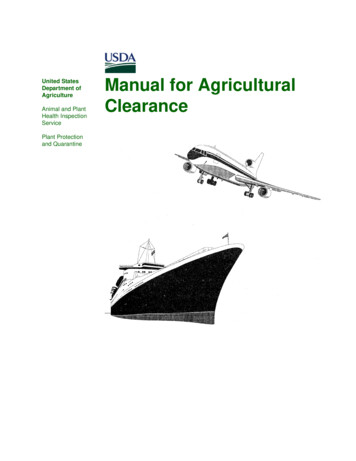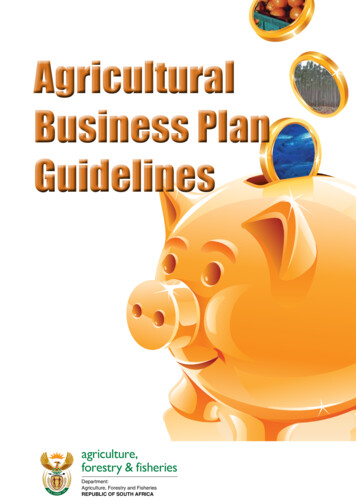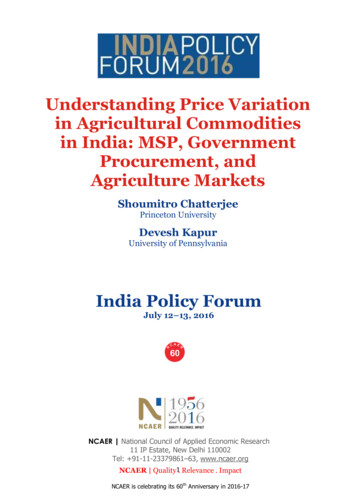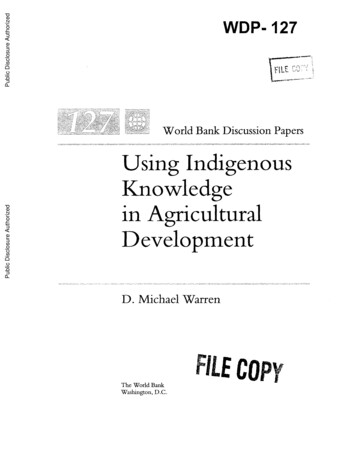
Transcription
PHILIPPINE AGRICULTURAL ENGINEERING STANDARDAgricultural Machinery – Seeder and Planter – Methods of TestPAES 123: 2001ForewordThis national standard is a revision of the AMTEC Standard Procedures of Inspection andTest series of 1980 – “Seeding Equipment With or Without Fertilizing Attachment”. Thepursuance of this standard was initiated by the Agricultural Machinery Testing andEvaluation Center (AMTEC) under the project entitled “Enhancing the Implementation ofAFMA Through Improved Agricultural Engineering Standards” which was funded by theBureau of Agricultural Research (BAR) of the Department of Agriculture (DA).This standard has been technically prepared in accordance with PNS 01-4:1998 (ISO/IECDirectives Part 3:1997) – Rules for the Structure and Drafting of International Standards.The word “shall” is used to indicate requirements strictly to be followed in order to conformto the standard and from which no deviation is permitted.The word “should” is used to indicate that among several possibilities one is recommended asparticularly suitable, without mentioning or excluding others, or that certain course of actionis preferred but not necessarily required.Upon adoption of the Department of Agriculture (DA) as National Standard, this revisedstandard will supersede AMTEC Standard Procedures of Inspection and Test series of1980.In the preparation of this standard, the following documents/publications were considered:Regional Network for Agricultural Machinery (RNAM) Test Codes And Procedures for FarmMachinery. Technical Series No. 12 :1983.Stevens G.N. Equipment Testing and Evaluation. Overall Division, National Institute ofAgricultural Engineering (NIAE), Wrest Park, Silsoe Bedford England. 1982.All annexes in this standard are normative.A-102
PHILIPPINE AGRICULTURAL ENGINEERING STANDARDPAES 123: 2001Agricultural Machinery – Seeder and Planter – Methods of Test1ScopeThis standard specifies the methods of test and inspection for various types of seeders andplanters such as manually-operated, animal-drawn and tractor power-driven drill and planterwith or without fertilizer applicator. This standard is not applicable to broadcaster andwetland seeder. Specifically, it shall be used to:1.1verify the requirements specified in PAES 122 and the specifications submitted by themanufacturer;1.2determine the laboratory performance of the seeder and planter; and1.3determine the field performance of the seeder and planter.2ReferencesThe following normative document contains provisions, which, through reference in this text,constitute provisions of this National Standard:PAES 122:2001, Agricultural Machinery – Seeder and Planter – SpecificationsPAES 103:2000, Agricultural Machinery – Method of Sampling3DefinitionsFor the purpose of this standard the definitions given in PAES 122 and the following shallapply:3.1fuel consumptionvolume of fuel consumed by the engine on per hour basisA-103
PAES 123:20013.2wheel slip of seeder or planterWheels slip is determined by the following formula:Wheel slip N1 N 0N1x 100where:N1N0is the sum of the revolutions of all driving wheels for agiven distance with slip, rpmis the sum of the revolutions of all driving wheels for thesame distance without slip, rpm4General Conditions for Test and Inspection4.1Seeder on TestThe seeder or planter submitted for test shall be taken from production model or series ofproduction and shall be sampled in accordance with PAES 103.4.2Role of the manufacturer/dealerThe manufacturer/dealer shall submit to the official testing agency the specifications andother relevant information on the seeder. An official representative shall be appointed toconduct minor repair, handle, adjust and witness the test. It shall be the duty of therepresentative to make all decisions on matters of adjustment and preparation of the machinefor testing. The manufacturer/dealer shall abide with the terms and conditions set forth by theofficial testing agency.4.3Running-in and preliminary adjustmentThe seeder to be tested shall be run-in prior to test as recommended by the manufacturer.4.4Test instruments and other needsThe instruments to be used shall have been checked and calibrated by the testing agency priorto the measurements. The seeds to be used during the test shall be of varieties presentlygrown in the Philippines.4.5Suspension of TestIf during the test run, the seeder stops due to breakdown or malfunction so as to affect theseeder’s performance, the test shall be suspended at the discretion of the test engineer andconcurred by the company representative.A-104
PAES 123:20015Test and Inspection5.1Verification of the Manufacturer’s Technical Data and Information5.1.1 This inspection is carried out to verify the mechanism, main dimensions, materialsand accessories of the seeder in comparison with the list of manufacturer’s technical data andinformation.5.1.2 A plain and level surface shall be used as reference plane for verification ofdimensional seeder specifications.5.1.3The items to be inspected and verified shall be recorded in Annex A.5.2Laboratory performance test5.2.1Test for metering mechanism5.2.1.1 This is carried out to examine the performance of metering mechanism, the result ofwhich can provide the basic data for the field performance.5.2.1.2 This test should be conducted on the kind of seed/fertilizers of which the machine issuitable as specified by the manufacturer.5.2.1.3 In case of hand seeder, the number of seeds delivered by one action of an operator’shand under appropriate adjustment of metering mechanism should be confirmed for each kindof seed.5.2.1.4 In case of other seeders, they are jacked up and the drive wheel of the meteringmechanisms is rotated in a number of revolutions to collect sufficient amount ofseeds/fertilizer to compute for its delivery rate. The delivery rates per hectare are calculatedwith the weight of seeds/fertilizer from the delivery tube with the corresponding distancetraveled by the seeder based on the number of revolutions of the drive wheel.5.2.1.5 If possible, this test shall be carried out at full, half and one-eight of the seeder’shopper capacity with three delivery rate settings – maximum, minimum and intermediate(around the mean of maximum and minimum).5.2.2Investigation on pattern of seed and fertilizer deposited5.2.2.1 This is carried out to investigate the pattern of seed and fertilizer deposited by theseeder.5.2.2.2 This test may be accomplished by running the seeder with full outfit over a greasedboard or a sheet of blanket or felt at the same speed as in the field. The seeds and fertilizerare trapped on the board or the sheet at the points where they fall.5.2.3The items to be investigated and measured shall be recorded in Annex B.A-105
PAES 123:20015.3Field performance test5.3.1 This test is carried out to obtain actual data on overall machine performance,operating accuracy, work capacity and adaptability to varied crops and field conditions.5.3.2 This test shall be conducted for at least two test trials for each kind of seed the seederis suitable.5.3.3 The seeds to be used for this test should be the same as the ones used in meteringmechanism test. Each test trial shall be conducted in an area of not less than 500 m2 formanual seeding implement and 1,000 m2 for power-operated seeders.5.3.4 Measure at random two-meters along each row for at least ten rows planted by theseeder. For each two meter distance, measure/record the following:5.3.4.1 depth of seeding5.3.4.2 distance between hills (if applicable)5.3.4.3 number of seeds planted per hill5.3.4.4 number of missed hill5.3.4.5 number of damaged/cracked seeds5.3.4.6 number of hills with incorrect number of seeds delivered5.3.5Other items to be measured, observed and computed are:5.3.5.1 Performance and accuracya. Space of rows plantedb. Population of seeds planted in unit areac. Rate of missing hill (in hill planting)d. Wheel slippage and sinkagee. Ease of handling and operationf. Ease of turningg. Ease of refilling seed or fertilizerh. Ease of adjustments5.3.5.2 Work rate and labor requirementA-106
PAES 123:2001a. Actual traveling speedb. Actual operating timec. Time spent for turning at headlandd. Time spent for adjustment of machinee. Time spent for machine troublef. Working capacity (ha/h)g. Fuel consumption (for tractor power-driven seeders)h. Required number of workers5.3.6The items to be measured and observed shall be recorded in Annex C.6Data AnalysisThe formulas to be used during calculations and testing are given in Annex D.7Test Report7.1Name of testing agency7.2Test report number7.3Title7.4Summary7.5Purpose and scope of test7.6Methods of test7.7Description of the machine7.7.1Table 1 – Machine Specifications7.8Table 2 – Laboratory Performance Test Data7.9Table 3 – Field Performance Test Data7.10Observations7.11Name and signature of test engineerAnnex AA-107
PAES 123:2001Inspection Sheet for SeederName of Applicant :Address :Telephone No. :Name of Distributor :Address :Name of Manufacturer :Factory Address :General InformationBrand : Model :Serial No. :Classification (hand seeder, planter, seed drill) S TO BE INSPECTEDITEMSA1 Dimensions and weight of the seederA1.1 Overall length, mmA1.2 Overall width, mmA1.3 Overall height, mmA1.4 Weight (hoppers empty), kgA2 Number of rows and row spacing, mmA3 Nominal working width, mmA4 Hill distance, mm (if applicable)A5 Seeds and their condition for whichequipment is suitableA6 Number of fertilizer openings andfertilizers for which the equipmentis suitableA7 Suitable field tion byTesting Agency:
PAES on byTesting AgencyA8 TravelingA8.1 Source of powerA8.1.1 ManualA8.1.2 Animal-drawnA8.1.3 Tractor power-drivenA8.1.3.1 Seed drillA8.1.3.2 PlanterA8.2 Recommended traveling speed ofequipment, kphA8.3 Recommended minimum drawbar outputof power tiller or tractor, kWA9 Metering MechanismA9.1 Type and method of changingdelivery rateA9.1.1 SeedA9.1.2 FertilizerA9.2 Source of power of metering mechanismA9.2.1 Ground wheelA9.2.2 PTOA9.2.3 OthersA9.3 Recommended PTO speed, rpm(if applicable)A9.4 Transmission mechanism and speedratio of metering shaft to input shaft(ground wheel or PTO shaft)A10 Hill-dropping mechanismA11 HopperA11.1 NumberA11.1.1 SeedA11.1.2 FertilizerA11.2 Capacity, LA11.2.1 SeedA11.2.2 FertilizerA11.3 MaterialA11.3.1 SeedA11.3.2 FertilizerA-109
PAES 123:2001ITEMSManufacturer'sSpecificationA12 Clutch for metering mechanismA12.1 TypeA12.2 LocationA13 Furrow or hole openerA13.1 TypeA13.2 MaterialA14 Seed covering deviceA14.1 TypeA14.2 MaterialA15 Location of fertilizer outlet related toseed outletA15.1 Fertilizer covering device (if applicable)A15.1.1 TypeA15.1.2 MaterialA16 Ground wheelA16.1 Diameter, mmA16.2 MaterialA17 Handle of animal-drawn equipmentA17.1 ConstructionA17.2 Height of handle from ground level, mmA17.3 Detail of adjustmentA18 Marking device (detail of marking)A19 Hitch shape and construction(in case of tractor mounted withcategory of three point linkage)A20 Safety arrangementA20.1 CoverA20.2 Power transmissionA20.3 Other moving partsA20.4 Other detailsA21 Recommended traveling speed, kphA22 Working capacity, ha/h(given by the manufacturer)A23 Any other detail (special features)Annex BA-110Verification byTesting Agency
PAES 123:2001Laboratory Performance Test Data SheetB1Seed MeteringDate of test :B1.1Test conditionB1.1.1 Conditions of seedsB1.1.1.1 Name of seed :B1.1.1.2 Variety of seed :B1.1.1.3 Shape :B1.1.1.4 Average size of seeds :Length, mm :Width, mm :Thickness,mm:B1.1.1.5 Weight of 1000 seeds, g :B1.1.1.6 Moisture content, % wb :B1.1.1.7 Bulk density, kg/L :B1.1.1.8 Purity (%), uniformity of size, etc :B1.1.2 Condition of grain seederB1.1.2.1 Metering shaft speed (adjustment, if any) :B1.1.2.2 Mechanism and speed :B1.1.2.3 Delivery opening adjustment :B1.2Delivery rateA-111
PAES 123:2001MaximumParticularsquantity of seedsin hopper11/2 1/8B1.2.1 Hand-operated metering (dibbler, jabber)B1.2.1.1 Number of seeds deliveredby one hand actionB1.2.1.2 Estimated delivery rate,kg/ha atrow spacing, mmhill distance, mmB1.2.1.3 Rate of damaged seed bymetering mechanism, %B1.2.2 Ground wheel-driven meteringB1.2.2.1 Effective rolling diameterof ground wheel, mB1.2.2.2 Revolution of groundwheel for measuringdeliveryB1.2.2.3 Delivery for B1.2.2.2,kgB1.2.2.4 Delivery rate, kg/haB1.2.2.5 Rate of damaged seeds bymetering mechanismB1.2.2.5 ObservationsB1.2.3 PTO-driven meteringB1.2.3.1 PTO speed, rpmB1.2.3.2 Tractor traveling speed inrelation to B1.2.2.1, kphB1.2.3.3 Time for measuringdelivery, sB1.2.3.4 Delivery for B1.2.2.3, kgB1.2.3.5 Delivery rate, kg/haB1.2.3.6Quantity of damagedseedsby metering mechanism, %B1.2.4 Pattern of seed deposition(line, band, hill, single seed,precision planting)B2A-112Fertilizer meteringDelivery rate settingIntermediateMinimumquantity of seeds quantity of seedsin hopperin hopper11/2 1/811/2 1/8
PAES 123:2001Date of test :B2.1Test conditionB2.1.1 Conditions of fertilizerB2.1.1.1 Kind :B2.1.1.2 Name :B2.1.1.3 Moisture content, % db :B2.1.1.4 Bulk density, kg/L :B2.1.2 Condition of grain B2.1.2.2 Mechanism and speed :B2.1.2.3 Delivery opening adjustment :B2.2Delivery rateParticularsDelivery rate settingMaximumIntermediateMinimumquantity ofquantity ofquantity offertilizer infertilizer infertilizer inhopperhopperhopper11/2 1/811/2 1/811/2 1/8B2.2.1 Ground wheel-driven meteringB2.2.1.1 Effective rolling diameterof ground wheel, mB2.2.1.2 Revolution of groundwheel for measuringdeliveryB2.2.1.3 Delivery for B2.2.1.2,kgB2.2.1.4 Delivery rate, kg/haB2.2.1.5 ObservationsB2.2.2 PTO-driven meteringB2.2.2.1 PTO speed, rpmB2.2.2.2 Tractor traveling speed inrelation to B2.2.2.1, kphB2.2.2.3 Time for measuringdelivery, sB2.2.2.4 Delivery rate
PAES 123:2001 5.3 Field performance test 5.3.1 This test is carried out to obtain actual data on overall machine performance, operating accuracy, work capacity and adaptability to varied crops and field conditions. 5.3.2 This test shall be conducted for at least two test trials for each kind of seed the seeder is suitable. 5.3.3 The seeds to be used for this test should be the same as the ones .
